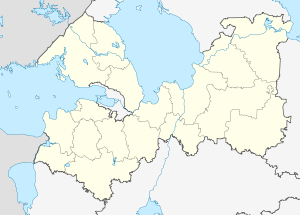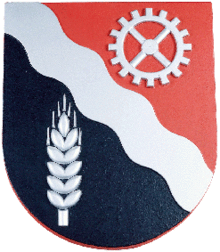Lesogorsky
| Lesogorsky (English) Лесогорский (Russian) | |
|---|---|
| - Urban-type settlement[1] - | |
|
| |
.svg.png) Location of Leningrad Oblast in Russia | |
 Lesogorsky | |
|
| |
| Administrative status | |
| Country | Russia |
| Federal subject | Leningrad Oblast |
| Administrative district | Vyborgsky District[1] |
| Municipal status (as of February 2010) | |
| Municipal district | Vyborgsky Municipal District[2] |
| Urban settlement | Svetogorskoye Urban Settlement[2] |
| Statistics | |
| Population (2010 Census) | 3,273 inhabitants[3] |
| Time zone | MSK (UTC+03:00)[4] |
| Urban-type settlement status since | 1940[5] |
| Previous names | Jääski (until 1949)[6] |


Lesogorsky (Russian: Лесого́рский; Finnish: Jääski) is an urban locality (an urban-type settlement) in Vyborgsky District of Leningrad Oblast, located on the left bank of the Vuoksi River, on the Karelian Isthmus, near the Russia–Finland border, and a station of the Kamennogorsk–Svetogorsk–Imatra railway. Population: 3,273 (2010 Census);[3] 3,004 (2002 Census);[7] 3,744 (1989 Census).[8]
Municipally Lesogorsky, together with the town of Svetogorsk, forms Svetogorskoye Urban Settlement of Vyborgsky Municipal District.
History
Jääski was first mentioned in 1323 in the Treaty of Nöteborg. Until 1710 it belonged to Sweden, and during the Great Northern War it was taken over by Russia. Until 1918 it was a part of Vyborg Governorate, which after 1812 belonged to the Grand Duchy of Finland and was known as the Viipuri Province. In 1918, Finland became independent, and the town became the administrative center of the Jääski municipality of the Viipuri Province.[9]
The territory had been ceded by Finland to the Soviet Union by the Moscow Peace Treaty as a result of the Winter War. It was recaptured by Finns between 1941 and 1944 during Continuation War but was again ceded to Soviets after Moscow Armistice. This cecession was formalized after signing Paris Peace Treaty in 1947. The Viipuri Province was divided, with the larger part ceded to Soviet Union and the smaller part remaining in Finland. The population was resettled to Finland, and population from Central Russia was resettled to populate the Karelian Isthmus.[5]
In March 1940 Yaskinsky District with the administrative center in Jääski was established, and Jääski obtained work settlement status. The district was a part of the Karelian Autonomous Soviet Socialist Republic, after March 31, 1940 of the Karelo-Finnish Soviet Socialist Republic.[5] On November 24, 1944, Yaskinsky District was transferred from Karelo-Finnish Soviet Socialist Republic to Leningrad Oblast. On October 1, 1948 the district was renamed Lesogorsky, and on January 13, 1949 Jääski was renamed Lesogorsky. On December 9, 1960 Lesogorsky District was abolished and merged into Vyborgsky District.[6]
Economy
Industry
In Lesogorsky, there is a plant producing plastic and fibers. There is a power plant on the Vuoksi.
Transportation
Lesogorsky is connected by railway with Kamennogorsk, where it has connection to the old Vyborg–Joensuu railroad. There is suburban traffic to Vyborg. The continuation of the railroad beyond Svetogorsk to the state border is disused.
Lesogorsky is connected by roads with Kamennogorsk and Vyborg, as well as with Imatra across the border via Svetogorsk.
References
Notes
- 1 2 Государственный комитет Российской Федерации по статистике. Комитет Российской Федерации по стандартизации, метрологии и сертификации. №ОК 019-95 1 января 1997 г. «Общероссийский классификатор объектов административно-территориального деления. Код 41 215 554 006», в ред. изменения №259/2014 от 12 декабря 2014 г.. (State Statistics Committee of the Russian Federation. Committee of the Russian Federation on Standardization, Metrology, and Certification. #OK 019-95 January 1, 1997 Russian Classification of Objects of Administrative Division . Code 41 215 554 006, as amended by the Amendment #259/2014 of December 12, 2014. ).
- 1 2 Law #17-oz
- 1 2 Russian Federal State Statistics Service (2011). "Всероссийская перепись населения 2010 года. Том 1" [2010 All-Russian Population Census, vol. 1]. Всероссийская перепись населения 2010 года (2010 All-Russia Population Census) (in Russian). Federal State Statistics Service. Retrieved June 29, 2012.
- ↑ Правительство Российской Федерации. Федеральный закон №107-ФЗ от 3 июня 2011 г. «Об исчислении времени», в ред. Федерального закона №271-ФЗ от 03 июля 2016 г. «О внесении изменений в Федеральный закон "Об исчислении времени"». Вступил в силу по истечении шестидесяти дней после дня официального опубликования (6 августа 2011 г.). Опубликован: "Российская газета", №120, 6 июня 2011 г. (Government of the Russian Federation. Federal Law #107-FZ of June 31, 2011 On Calculating Time, as amended by the Federal Law #271-FZ of July 03, 2016 On Amending Federal Law "On Calculating Time". Effective as of after sixty days following the day of the official publication.).
- 1 2 3 История Выборгского района, история Выборгской земли (in Russian). Муниципальное образование Выборгский район Ленинградской Области. Retrieved 16 May 2013.
- 1 2 Яскинский район (нояб.1944 - окт.1948), Лесогорский район (окт.1948 - дек.1960) (in Russian). Система классификаторов исполнительных органов государственной власти Санкт-Петербурга. Retrieved May 16, 2013.
- ↑ Russian Federal State Statistics Service (May 21, 2004). "Численность населения России, субъектов Российской Федерации в составе федеральных округов, районов, городских поселений, сельских населённых пунктов – районных центров и сельских населённых пунктов с населением 3 тысячи и более человек" [Population of Russia, Its Federal Districts, Federal Subjects, Districts, Urban Localities, Rural Localities—Administrative Centers, and Rural Localities with Population of Over 3,000] (XLS). Всероссийская перепись населения 2002 года [All-Russia Population Census of 2002] (in Russian). Retrieved August 9, 2014.
- ↑ Demoscope Weekly (1989). "Всесоюзная перепись населения 1989 г. Численность наличного населения союзных и автономных республик, автономных областей и округов, краёв, областей, районов, городских поселений и сёл-райцентров" [All Union Population Census of 1989: Present Population of Union and Autonomous Republics, Autonomous Oblasts and Okrugs, Krais, Oblasts, Districts, Urban Settlements, and Villages Serving as District Administrative Centers]. Всесоюзная перепись населения 1989 года [All-Union Population Census of 1989] (in Russian). Институт демографии Национального исследовательского университета: Высшая школа экономики [Institute of Demography at the National Research University: Higher School of Economics]. Retrieved August 9, 2014.
- ↑ Лесогорское городское поселение (in Russian). ucoz.ru. Retrieved 3 June 2013.
Sources
- Законодательное собрание Ленинградской области. Областной закон №32-оз от 15 июня 2010 г. «Об административно-территориальном устройстве Ленинградской области и порядке его изменения», в ред. Областного закона №23-оз от 8 мая 2014 г. «Об объединении муниципальных образований "Приморское городское поселение" Выборгского района Ленинградской области и "Глебычевское сельское поселение" Выборгского района Ленинградской области и о внесении изменений в отдельные Областные законы». Вступил в силу со дня официального опубликования. Опубликован: "Вести", №112, 23 июня 2010 г. (Legislative Assembly of Leningrad Oblast. Oblast Law #32-oz of June 15, 2010 On the Administrative-Territorial Structure of Leningrad Oblast and on the Procedures for Its Change, as amended by the Oblast Law #23-oz of May 8, 2014 On Merging the Municipal Formations of "Primorskoye Urban Settlement" in Vyborgsky District of Leningrad Oblast and "Glebychevskoye Rural Settlement" in Vyborgsky District of Leningrad Oblast and on Amending Various Oblast Laws. Effective as of the day of the official publication.).
- Законодательное собрание Ленинградской области. Областной закон №17-оз от 10 марта 2004 г. «Об установлении границ и наделении соответствующим статусом муниципальных образований Всеволожский район и Выборгский район и муниципальных образований в их составе», в ред. Областного закона №23-оз от 8 мая 2014 г. «Об объединении муниципальных образований "Приморское городское поселение" Выборгского района Ленинградской области и "Глебычевское сельское поселение" Выборгского района Ленинградской области и о внесении изменений в отдельные Областные законы». Вступил в силу со дня официального опубликования. Опубликован: "Вести", №27, 11 марта 2004 г. (Legislative Assembly of Leningrad Oblast. Oblast Law #17-oz of March 10, 2004 On Establishing the Borders of and Granting an Appropriate Status to the Municipal Formations of Vsevolozhsky District and Vyborgsky District and to the Municipal Formations Comprising It, as amended by the Oblast Law #23-oz of May 8, 2014 On Merging the Municipal Formations of "Primorskoye Urban Settlement" in Vyborgsky District of Leningrad Oblast and "Glebychevskoye Rural Settlement" in Vyborgsky District of Leningrad Oblast and on Amending Various Oblast Laws. Effective as of the day of the official publication.).